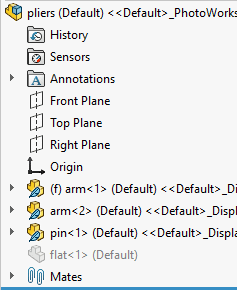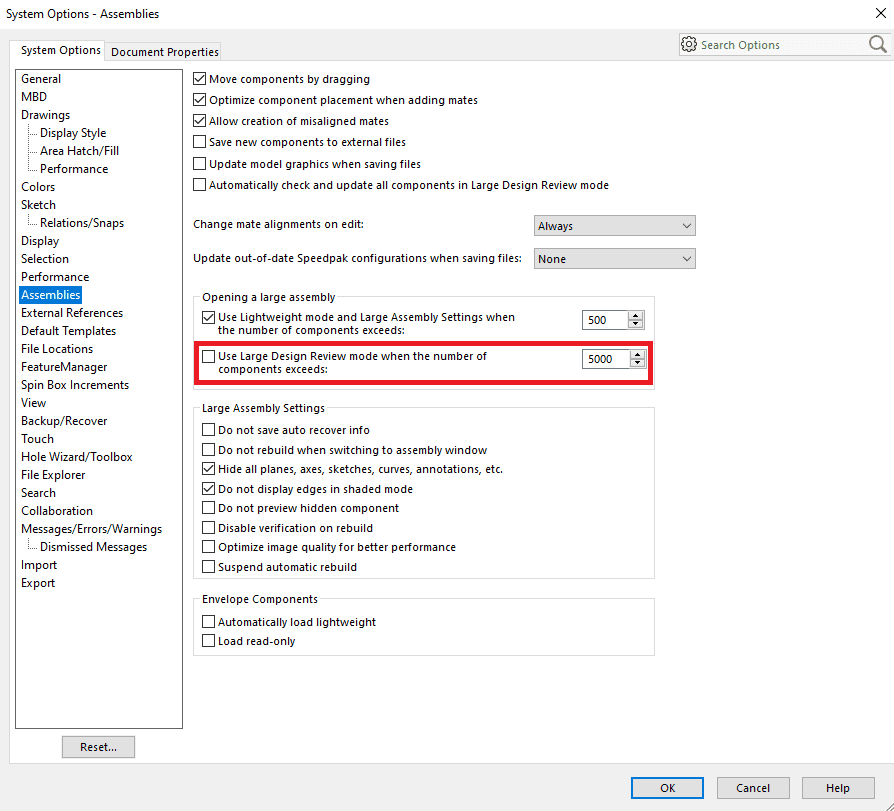IMPROVING LARGE ASSEMBLY PERFORMANCE - Part 4, SOLIDWORKS Assembly Tools
In my last blog post, I talked about SOLIDWORKS settings for improving large assembly performance. In that part 3 of my Improving Large Assembly Performance series, I talked about performance settings in SOLIDWORKS’ System Options. I also talked about suspending automatic rebuild, lowering image quality, changing display settings, and disabling all of the following: Realview Graphics, Auto-Recover, News Feeds, File Search/Dissection, and Add-Ins. Now, in part 4 of my series, I will focus on SOLIDWORKS large assembly ‘tools’ that you can use to improve performance. With the sheer number of tools however, I will probably break this up into multiple posts. So, stay tuned.
When opening large assemblies and drawings, you will spend the most time waiting for the data in the referenced components to load. As this can be thousands of files for the largest assemblies, this can take a while. The following group of tools is designed to optimize your files and make this action as fast as possible.
PRODUCT DATA MANAGEMENT
Opening and saving your files over a network is slower than opening or saving files locally. Depending on your network and the network load at any given time, it can be MUCH slower. Even if documents are stored and maintained on a central server, it is still more efficient to copy those files locally, make your changes, and then copy those files back.
A solution like SOLIDWORKS PDM could save many hours in searching, opening, and working with large assembly and drawing files. With PDM, a vault can be ‘replicated’, and files can be checked out locally from any location. Engineers would have secure access to the files, workflows for SOLIDWORKS components and other document types, extensive search capabilities, and revision control. Engineers could also automate the creation of PDF’s and other documents that might be part of their everyday processes, like purchase requisitions or engineering change orders. A tool like PDM has many uses in improving our everyday performance issues. Below, you will see how this PDM interface looks. And feel free to contact CATI for a demonstration of this amazing tool.

TASK SCHEDULER (Convert to latest release)
With each new release of SOLIDWORKS, your models may need to be updated to prepare them for code changes in the latest release. This happens automatically when you open an older version file in a new version of SOLIDWORKS, but it can result in longer open times. The good news is that you only have to do this once per file. Conversion can be done as needed on an active project/model by opening and saving a file, OR, to save time, it can be done on entire data sets in an automated way using Task Scheduler or PDM software.
LIGHTWEIGHT COMPONENTS
You can improve the performance of large assemblies significantly by using Lightweight Components. You can load a part or an assembly with its active components Fully Resolved or Lightweight
-
- SOLIDWORKS loads all model data into memory for Fully Resolved components.
- SOLIDWORKS only loads a subset of the model data into memory for Lightweight components. SOLIDWORKS then loads the remaining model data as-needed basis.
Lightweight Components Appear with Feather

There are limitations to the functions you can perform while your components Lightweight. However, when you do need to make design changes, simply right click on the component, and select Fully Resolved. Or simply expand the part tree within the assembly, as seen below. You’ll notice that the first two items are lightweight, while the pin, whose tree has been expanded, is now resolved.

There are a number of options for making components Lightweight. A feather icon will appear on the component in the FeatureManager design tree to indicate that it is Lightweight.
- Select Lightweight under Mode in the Open dialogue window.
- RMB on a component in an assembly and select Lightweight from the shortcut menu.
- Set a system option to automatically open assemblies lightweight. You’ll find this setting under Tools > Options > System Options > Performance > Assembly Loading. Just check the box ‘Load Component Lightweight’.
LIGHTWEIGHT MODE WITH LARGE ASSEMBLY SETTINGS
Lightweight Mode with the Large Assembly Settings is a collection of system settings that improves the performance of assemblies. You can turn on Lightweight Mode at any time, or SOLIDWORKS can activate it automatically when you cross a set threshold for the number of components. When using this mode, SOLIDWORKS loads components as lightweight by default, as well as other various performance options. You’ll find this option under Tools > Options > System Options > Assemblies > Opening a Large Assembly and Large Assembly Settings.

LARGE DESIGN REVIEW
SOLIDWORKS has a great tool called Large Design Review for quickly accessing massive assemblies on moderate hardware. Large Design Review allows users to open assemblies almost instantly while still allowing them plenty of interactivity. All of the familiar view manipulation tools are available. You can zoom, pan, and rotate as if you are working on a single part. You can hide and show different items for a more granular focus. Window selection tools are available as well as the Isolate command to gain better clarity on specific areas.
You can quickly create Walk-Throughs and Snapshots to gain a thorough understanding of a large design. These tools allow you to quickly navigate to various areas of the assembly. And finally, the Measure tool is also available in Large Design Review mode to gain a dimensional understanding of a design such as clearances. Now, although you can open components in their own window for editing, there are some assembly editing capabilities in Large Design Review mode as well. Please follow this link to take a deeper look into Large Design Review, including the Edit Assembly mode, which was introduced in SOLIDWORKS 2019.
Whether it’s for design reviews or just to locate and edit specific components, Large Design Review Mode enables you to quickly access massive assemblies with minimal overhead or hardware. Simply select Large Design Review from Mode in the Open Dialogue window. You can also set a threshold for the number of components that triggers Large Design Review Mode after clearing the threshold. You can find this option under Tools > Options > System Options > Assemblies > Opening a Large Assembly.

So, if you are having issues with large assembly performance, try these SOLIDWORKS tools. You may not use all of them, but any that you can take advantage of, the better your performance. And stay tuned for my next post, part 5 of my ‘Improving Large Assembly Performance’ series, where I continue talking about the different tools that SOLIDWORKS has to offer for large assembly performance issues.
Regards.
Ken LaVictor
Sr. Applications Engineer
Computer Aided Technology

 Blog
Blog